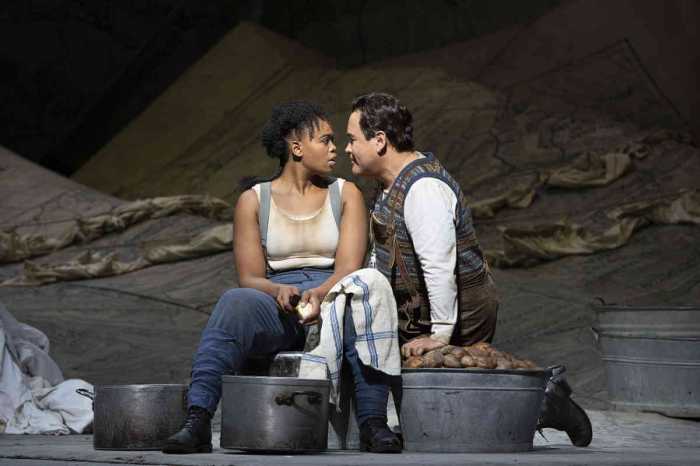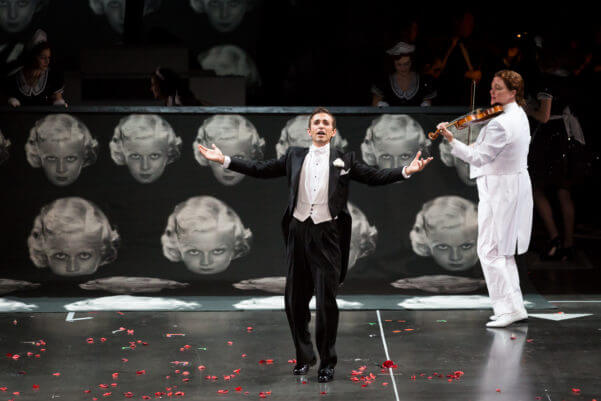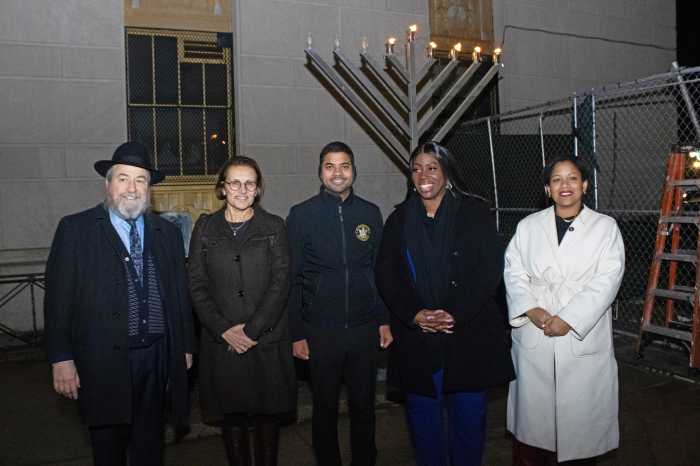Bernard Holcomb and Cecilia Violetta López in the LoftOpera production of Rossini’s “Otello.” | ROBERT ALTMAN
In late March, LoftOpera upped its game with a vital, musically ambitious revival of Rossini’s 1816 version of “Otello” presented at the LightSpace Studios in Bushwick. Often with LoftOpera one takes the rough edges with the smooth — the atmosphere is loft party meets art happening and the action often spills into the audience space. The youth of the performers and audience alike makes up in enthusiasm for some clumsiness in execution and primitive ad hoc design and direction.
Music director Sean Kelly had difficulties maintaining orchestral balance and ensemble in an open space with high ceilings and reverberant acoustics. But the beauties of Rossini’s music emerged clearly all night despite passing flubs. The artistic whole was greater than the sum of the parts as a committed ensemble worked together to bring a seminal 19th century masterpiece to vibrant life in the 21st century.
John de los Santos’ bare bones production reset the action to the Italy of the 1950s, with the men in business suits and the women in elaborately brocaded cocktail gowns. The direction strove for economy and elegance and, at its best, succeeded. Francesco Maria Berio di Salsi’s libretto streamlines Shakespeare, eliminating the fatal incriminating handkerchief and the role of Cassio. A mislaid, unaddressed love letter from Desdemona to Otello replaces the handkerchief as the catalyst for murder. Rodrigo, a very determined suitor for Desdemona’s hand, is conflated with Cassio. Iago is a much less complex figure and less dominant in the plot than his Shakespeare or Verdi counterparts. Iago, like all the male principals a coloratura tenor, has no solo aria, just duets with Otello and Rodrigo, relegating him to near comprimario status.
LoftOpera steps up with Rossini’s “Otello”, Opera Philadelphia presents “Tancredi” beautifully
The LoftOpera production attempted to restore these lost elements: the handkerchief was reintroduced by Otello presenting it to Desdemona during the overture. After Iago steals it, the handkerchief enfolds a lock of Desdemona’s hair enclosed in the misdirected love letter, further proving her perfidy.
Iago (Blake Friedman) is played as a sexually ambiguous Waldo Lydecker society dandy dressed in velvet jacket and ascot. The musically and dramatically more prominent Rodrigo (Thor Arbjornsson) is recast as the primary villain portrayed as a Patrick Bateman preppy psychopath acting as Iago’s co-conspirator and manipulator. Some scholars have surmised repressed homosexual desires underlying Iago’s hatred of Othello. This Iago seemed to be obsessed with Rodrigo.
The singing was a mixed bag with one absolute star turn. In the title role, Bernard Holcomb revealed a sweet full lyric tenor that sometimes conquered the heroic coloratura and sometimes stumbled over it. His stage demeanor lacked gravitas and menace, particularly in the later acts. Arbjornsson’s Rodrigo cut a handsome figure and confidently handled the high tessitura and florid writing but his timbre is dry and less than ingratiating. Iago’s music is lower and less showy but Friedman possessed the smoothest vocal emission of the male leads.
Isaiah Musik-Ayala as Desdemona’s father Elmiro impressed with a velvety but booming bass tone. The role of Desdemona made the reputation of such great 19th century bel canto divas as Isabella Colbran, Giuditta Pasta, and Maria Malibran. Cecilia Violetta López proved a worthy successor as Desdemona – not a tragic noble victim in the Pasta mode but a passionate spitfire in the Malibran manner. The end of Act II where Otello denounces Desdemona’s supposed betrayal and goes off to duel with Rodrigo occasioned a multi-part bravura coloratura meltdown for Desdemona that López tore into with unhinged abandon, not missing a grace note. She openly defied Otello in her death scene, daring him to kill her. López’s agile soprano is sweet and creamy on the surface but underlaid with dark smoky spinto colors.
Rossini’s version of “Otello” brings Romantic intensity to the opera seria format that stresses classical order and formalism. In Act III’s murder scene, the closed musical forms loosen and the orchestra equals the vocal line in musical importance. Dramatic intensity trumps formal structure and Romantic opera emerges. Composers throughout Europe followed Rossini’s lead.
Rossini’s first opera seria triumph was the more classical “Tancredi” (1813), which was presented in a beautiful production by the Opera Philadelphia in February. Based on a tragedy by Voltaire, Rossini’s youthful breakout hit concerns another warrior hero, Tancredi, who believes his beloved Amenaide is guilty of betrayal both romantic and political by means of a misdirected, unaddressed love letter originally intended for him.
Unlike Otello, Tancredi publically defends his love’s honor in combat despite believing the accusations tying her to the Saracen enemy Solamir. Opera Philadelphia performed Rossini’s tragic Ferrara finale, where Tancredi is mortally wounded in battle only learning of Amenaide’s innocence after it is too late and dying in her arms (as in Voltaire’s play).
Brenda Rae and Stephanie Blythe in Opera Philadelphia's production of “Tancredi.” | KELLY & MASSA
Tancredi was performed by mezzo-soprano Stephanie Blythe in a reassuring return to commanding vocal form. Blythe eschewed the multi-octave embellishments favored by Marilyn Horne and Ewa PodleÅ› but sang the role with noble simplicity in the contralto range. Her coloratura lacks the speed of PodleÅ› or Horne but Blythe didn’t simplify anything. The breadth and depth of Blythe’s tone created a formidable hero despite the occasional rasp on high notes. I think the heroic bel canto contralto repertory might be a wise repertory path for Blythe. It spares her the rigors of the dramatic Verdi mezzo repertory or being relegated to aging character mezzo status while still in her 40s.
The spare almost Gluckian final death scene was eloquently performed by Blythe and rising American coloratura Brenda Rae as Amenaide. Rae was a revelation, singing Amenaide’s high florid vocal line with pinpoint accuracy and tight trills. If her text sometimes emerged unclear in the high range, her emotional engagement never wavered. Michele Angelini as Argirio looked and sounded rather boyishly youthful for the heroine’s father but his pingy light tenor sailed through the roulades with panache. Daniels Mobbs’ smooth basso cantante matched his elegantly sinister portrayal of the villainous silver-haired accuser Orbazzano.
Director Emilio Sagi brought human touches to the secondary roles of the confidante Isaura, sung richly by Allegra De Vita, and the coltish page Roggiero, sung with a brightly boyish mezzo by Anastasiia Sidorova. Sagi reset the action sometime in pre-World War I Europe with sets by Daniel Bianco that mixed classical architecture with art nouveau elements. The costumes by Pepa Ojanguren also were vaguely 19th century but mixed periods and styles. Corrado Rovaris conducted a rhythmically vibrant but tightly controlled performance – he would be a welcome presence at the Metropolitan Opera.
The elegantly appointed, medium-sized Philadelphia Opera House is the perfect space for early 19th century opera. It resembles European opera houses of the period in its combination of intimacy and grandeur.





































